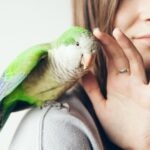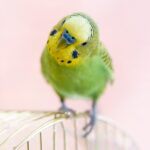The 13 Best Pet Birds: Parakeets, Cockatiels, and More
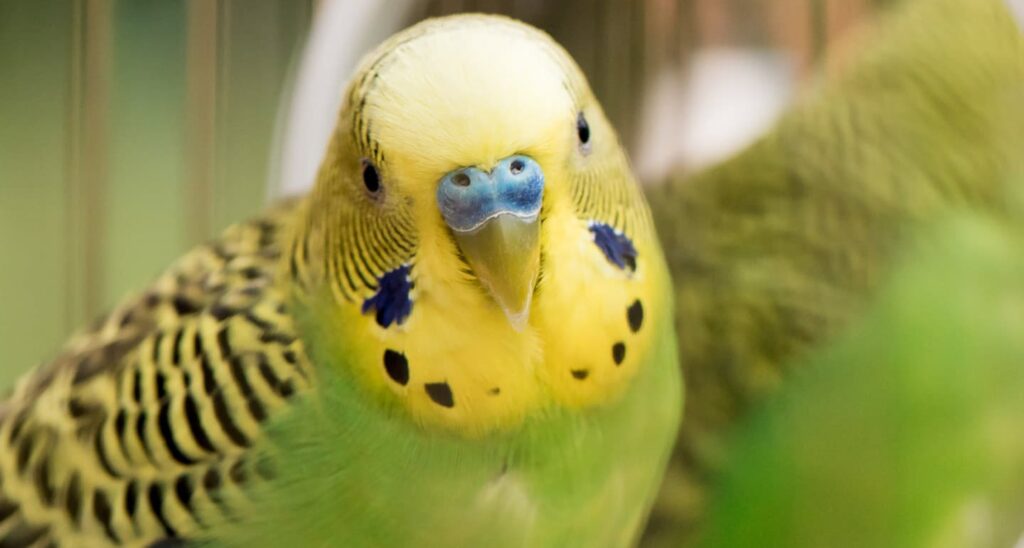
Photo by iStock.com/Lusyaya
From small finches to large Amazon parrots with even larger personalities, birds can make wonderful pets. But before getting a new feathered friend, you need to do a little research first. That’s because some birds, like parakeets and canaries, are great for beginners, while others, like cockatoos and macaws, are better suited for experienced bird owners.
We spoke to two bona fide bird experts Dr. Laurie Hess, DVM, DABVP (Avian Practice), owner of Veterinary Center for Birds & Exotics in Bedford Hills, New York, and Long Island Parrot Society’s former president Susan Chamberlain, to identify the best pet birds and learn a little about each one so you can find the right fit for your flock.
Top 10 Pet Birds
1. Parakeets

iStock.com/Sisoje
BEST FOR: First-time pet bird parents with time to teach these fun birds a few tricks. Chatty but not screechy, they’re appropriate for most apartment- and townhouse-dwellers.
Outside of the U.S., “parakeet” refers to several species of small and medium birds in the parrot family. One of the most popular? The budgerigar, or budgie. Silly and sweet birds with big personalities, budgerigars are a fantastic, low-maintenance choice for beginners. They make less noise than their larger relatives, chirruping pleasantly. With patience, you can even teach them to repeat some human words. Another popular type is the Lineolated parakeet (also known as linnies, barred parakeets, or Catherine parakeets). They are similarly easygoing and able to learn tricks.
All About Parakeets, Budgies, and Linnies
- Average size and weight: 6 to 8 inches, 1 ounce
- Average lifespan: 6 to 8 years, but if you take care of them properly (regular vet visits, nutritious food) they can live much longer
- Sociability: Properly tamed and cared for, can be very friendly and affectionate
- Talking ability: Very chatty! You can train parakeets to pick up human voices and learn words and phrases.
- Medical concerns: Includes bacterial infections, viruses or parasites, and fatty liver disease
How To Keep Them Happy
Housing: Must be wide and tall enough for easy movement and exercise. The 53-inch tall Prevue Pet Products Wrought Iron Flight Cage gives small and medium birds plenty of space.
Toys: Should be no bigger than your parakeet; ones with paper or hay to shred or bells to ring are good at keeping your bird entertained. This Super Bird Creations crinkle toy has both.
Food: Provide fresh water daily and several small bowls of food in the cage so they can fly from one to another. Feed them pellets like Lafeber’s Gourmet Pellets mixed with a few seeds and fresh veggies, like carrot strips or broccoli florets. Avoid too many empty calories (like seeds and grains).
2. Cockatiels
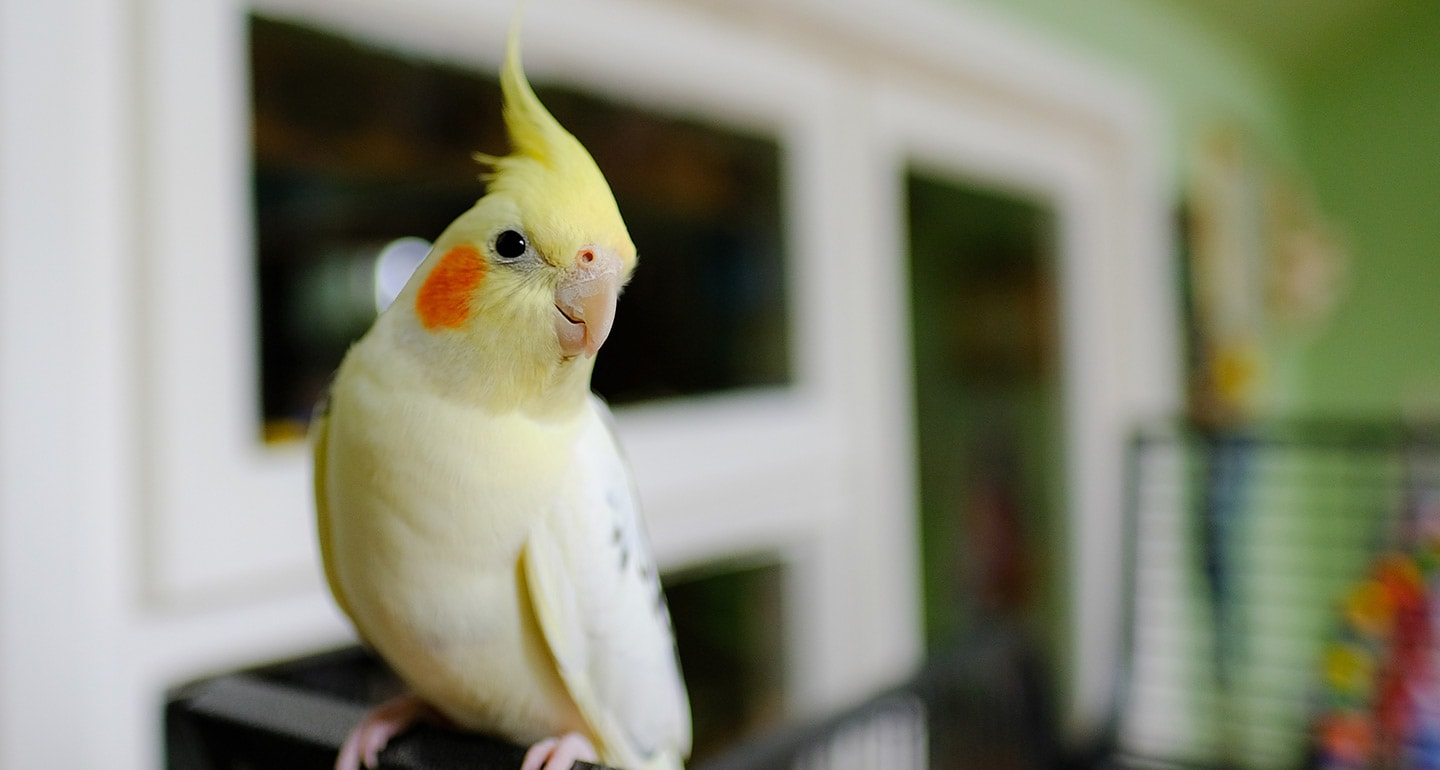
iStock.com/Nickbeer
BEST FOR: Cockatiels are a popular pet bird for new pet owners. They’re just big and smart enough to be fun, interactive, and social, but they’re small enough to be manageable. Prepare to give them at least an hour or two of out-of-cage time a day, and as much quality attention as you can. The more attentive you are, the stronger and better your bond will be.
Affectionate, spirited, and curious, these pint-size parrots are members of the cockatoo family (also known as miniature cockatoos, weiros, and quarrions), and good introductory birds, especially if you have kids. If these birds are handled young, trained, and socialized, their sunny, easygoing personalities shine. Expect whistles (they can be pretty vocal) and kisses.
All About Cockatiels
- Average size and weight: 12 inches, 3 ounces
- Average lifespan: 10 to 15 years
- Sociability: Cockatiels do fine as an only pet but need to interact with you
- Talking ability: Very talkative! Can be trained to mimic sounds and sing, whistle and make all sorts of noises
- Medical concerns: Includes bacterial infections, viruses or parasites, obesity and fatty liver disease
How To Keep Them Happy
Housing: Cockatiels require roomy cages with perches of varying materials. Pair a rope perch like the JW Pet Medium Comfy Bird Perch with Prevue Pet Products’ Wood Corner Shelf. Cockatiels like to bathe in their water bowls—get a big enough bowl, such as JW Pet InSight Clean Cup and change the water twice a day.
Toys: Cockatiels need plenty to do, so provide toys that can entertain these intelligent birds when unattended. These could include foraging and shredding toys, such as this Bonka Bird Toys foraging toy—and be sure to change up their toys every week.
Food: Provide fresh water daily and several small food bowls they can fly between. Cockatiels can gain weight quickly, so give them more pellets and vegetables than seeds and treats and ensure plenty of room in their cage to flap, fly, and move.
3. Canaries

iStock.com/Thomas Demarcyzk
BEST FOR: Crazy-busy first-time pet bird parents who aren’t looking for a talking bird but are happy to listen to their canary sing as they do other things. Smaller in size and relatively quiet; suitable for apartment-dwellers.
Beautiful, good-natured songsters, canaries require low-key TLC; they’re for looking at and listening to. They typically don’t like to be handled, but they’ll appreciate living in the same room where you spend time. Canaries are curious and will investigate anything new in their environment, but they won’t hang out with you. Males sing operatically while females have a gentle chirp.
All About Canaries
- Average size and weight: 3 to 4 inches, 1 ounce
- Average lifespan: 10 to 15 years, often longer
- Sociability: They like to hang out in the same room as you, but are not the most snuggly of birds.
- Talking ability: They don’t “speak,” but expect plenty of song from males. Females tend to mostly chirp.
- Medical concerns: Respiratory illness and obesity. Canaries have very sensitive respiratory systems, which can be easily compromised.
How To Keep Them Happy
Housing: It’s all about bar spacing. You want a cage that has no more than a quarter of an inch between the bars so they don’t get their heads stuck. Canaries can be quite comfortable in a cage like the Vision II Model M02 bird cage, with perches set at different heights. If you let your canary out to fly around in the room, cover windows and mirrors so they don’t crash.
Toys: Canaries love bird-safe bells, things that make sounds, and anything soft. Consider the top-rated JW Pet InSight Cuttlebone Holder bird toy or JW Pet Activitoy bell toy.
Food: Pellets, supplemented with vegetables like kale, spinach, and sweet potatoes. Avoid too many sugary fruits (like bananas or grapes) and provide fresh water daily.
4. Conures

iStock.com/cirminalatt
BEST FOR: You don’t need prior bird experience to own a conure, but it helps to know what you’re in for: a very vocal companion. They can screech, so they’re better for homes without close neighbors. Conures need plenty of quality time, enriching toys, and one-on-one attention.
Intelligent, playful conures come in various sizes, types, and colors, from the smaller green-cheeked conure to the larger sun and blue-crowned conures. They’re handleable and clownish. They play games. They can be sassy and destructive if startled, scared, or not appropriately socialized.
All About Conures
- Average size and weight: 10 to 15 inches, 3 to 9 ounces
- Average lifespan: 20+ years
- Sociability: As long as they’ve been socialized properly, they respond to their owners well. They love to be in the center of the household action.
- Talking ability: In general, conures aren’t known for their ability to talk. Of course, yours may surprise you.
- Medical concerns: Avian bornavirus, obesity
How To Keep Them Happy
Housing: Conures love roomy cages! Their tails must not touch the bottom; they need ample space for unrestricted movements and several perches.
Toys: Enrichment items, foraging toys like Super Bird Creations Foraging Basket, and different things to rip up and chew. Conures can screech if they get bored or don’t get enough attention. And remember: the larger the bird the more time they need out of the cage.
Food: Pellets, vegetables, and some fruits. ZuPreem VeggieBlend was formulated with birds like conures in mind and includes flavors like carrots, green beans, and beets. Provide fresh water daily.
5. African Greys
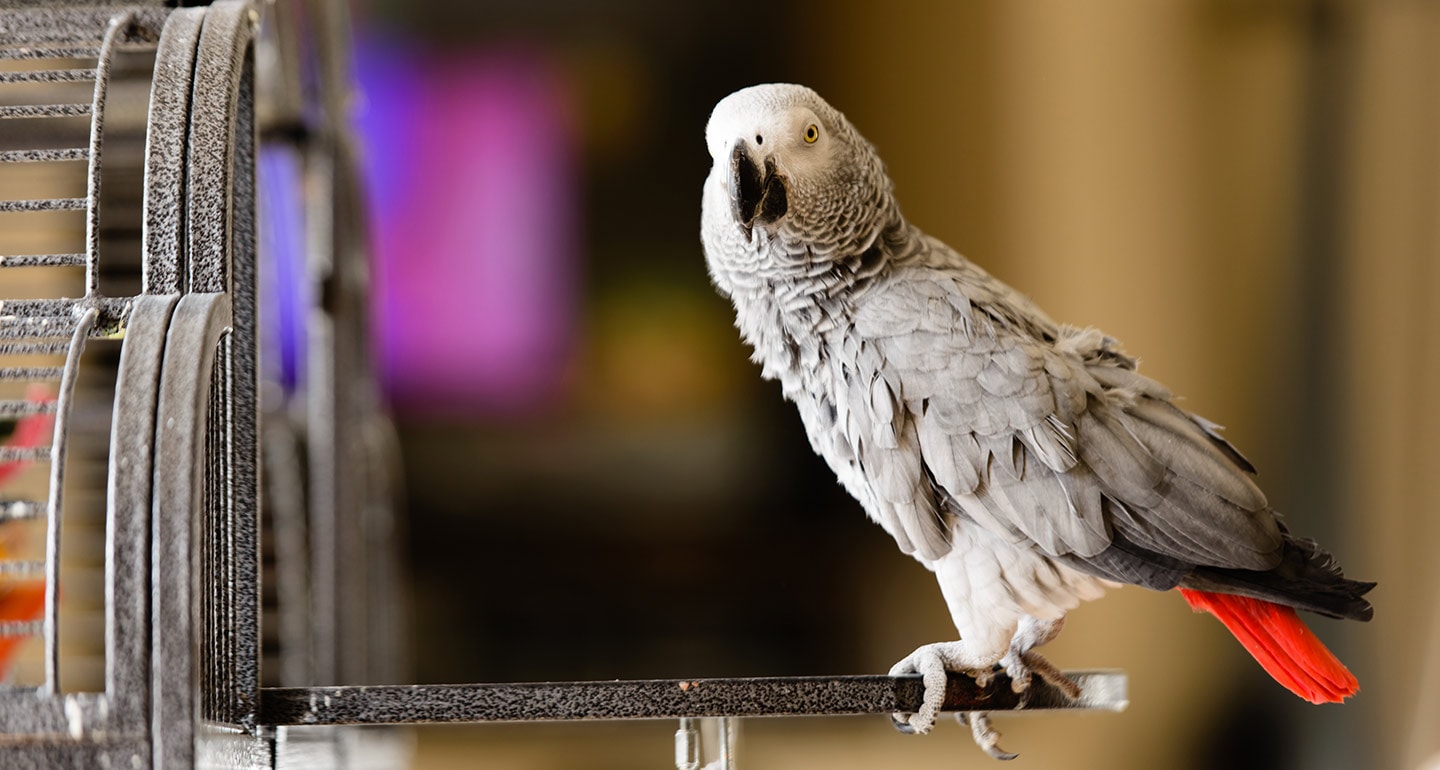
iStock.com/WhitneyLewisPhotography
BEST FOR: Experienced pet bird parents who are comfortable with spending time and energy keeping these super-smart parrots stimulated—and are patient enough to put up with a pet who loves to mimic any sound at top volume.
The African grey is considered the best talker of all the talking birds. This medium-sized parrot is super intelligent, charming, and friendly. Because they’re so bright, African greys need plenty of mental stimulation; a bored African grey can be trouble. As young pets, they’re fun and generally love everyone in the family. When they sexually mature at 5-7 years of age however, they may bond with one person and become overprotective.
All About African Greys
- Average size and weight: 13 to 15 inches, 14 ounces
- Average lifespan: 30+ years. They can live to 50 years old if you feed them an appropriate amount of fresh vegetables and a pelleted diet low in seeds, and take them to the vet regularly for check ups.
- Sociability: They love to hang with you but can get bored easily, which can sometimes lead to aggression.
- Talking ability: Not all talk, but all imitate and repeat sounds all day.
- Medical concerns: Fungal infections, parasites, mites, allergies
How To Keep Them Happy
Housing: Purchase the largest cage that you can fit into your space; they should be able to fully extend their wings and flap them without touching cage walls.
Toys: Because African greys are foragers and solution-seekers by nature, toys like Super Bird Creations PVC Forager Bird Toy, or just something puzzle-like such as undoing knotted rope, will keep them entertained.
Food: Pellets, vegetables, and some low-in-sugar and high-in-phytonutrient fruits (such as papayas, berries, and kiwis). High-quality, fresh-grade walnuts in the shell provide omega-3s. Provide fresh water daily.
Learn more about what you should feed your African grey parrot.
6. Amazon Parrots

iStock.com/YES BRASIL
BEST FOR: The parrot-savvy and young; you don’t want your bird to outlive you. You should love routine and have plenty of time each day to care for and play with these easily bored birds.
Be ready to be in it for the long haul—Amazon parrots can easily reach 40 years old. They’re intelligent, social creatures and need constant interaction and attention. They can be quite a handful, with dominant, opinionated personalities. They come in different colorways that correspond to slight personality differences. Yellow-naped and double yellow headed Amazons, for instance, are extra talkative; southern mealy Amazons are the most docile; and blue-fronted Amazons love to clown around.
Note: Many older Amazon parrots were wild-trapped, which is now illegal in this species and many others. Seek out reputable captive-bred birds from breeders who actively support conservation efforts.
All About Amazon Parrots
- Average size and weight: 10 to 17 inches, 10 to 27 ounces
- Average lifespan: 40 to 50 years
- Sociability: Like all parrots, they need a lot of attention. Babies are especially friendly.
- Talking ability: Amazons are great talkers. They readily pick up words and phrases.
- Medical concerns: Obesity and heart disease, respiratory illnesses
How To Keep Them Happy
Housing: Purchase the largest cage that you can fit into your space; they should be able to fully extend and flap their wings without touching the cage walls.
Toys: Provide lots of social interaction and mentally stimulating, weekly rotating toys (foraging, shredding, puzzles). Try JW Pet Hol-ee Roller Bird Toy and Super Bird Creations Bottoms Up Bird Toy, which presents a challenge with see-through canisters that you fill with treats.
Food: A typical diet consists of pellets, plenty of vegetables, and low-sugar fruits. Provide fresh water daily.
7. Parrotlets

iStock.com/Sisoje
BEST FOR: Newbie pet bird parents with young families. Parrotlets are a fantastic addition to a family with elementary-aged children. Their small size and moderate noise level mean you can keep them in apartments and townhouses.
Charming parrotlets, affectionately known as “pocket parrots,” are fantastic entry-level parrots. They may be tiny, but they have big, charismatic personalities, and you can train them to do all sorts of things, from stepping onto your finger to turning around and waving. They’re lovable and easy to maintain, though sometimes territorial.
All About Parrotlets
- Average size and weight: 4 to 5 inches, 1 ounce
- Average lifespan: 15 to 20 years
- Sociability: They thrive on attention—place cage in the family room or near the kitchen so they can see what’s going on.
- Talking ability: They can be taught to say words and are not as noisy as other types of parrots.
- Medical concerns: Yeast infections
How To Keep Them Happy
Housing: The larger the cage, the happier they’ll be. They should be able to fully extend their wings without getting wing and tail feathers caught on the sides or bottom.
Toys: Give them plenty of things to do, such as climbing a rope ladder (Prevue Pet Products Naturals Rope Ladder), foraging for treats (Bonka Bird Toys foraging toy), and ringing a bell (Super Bird Creations Daisy Ring).
Food: Supplement food pellets with vegetables (kale, spinach, broccoli florets) and fruits that are low in sugar; they are more inclined to eat fresh foods if minced small. Provide fresh water daily.
8. Pionus Parrots
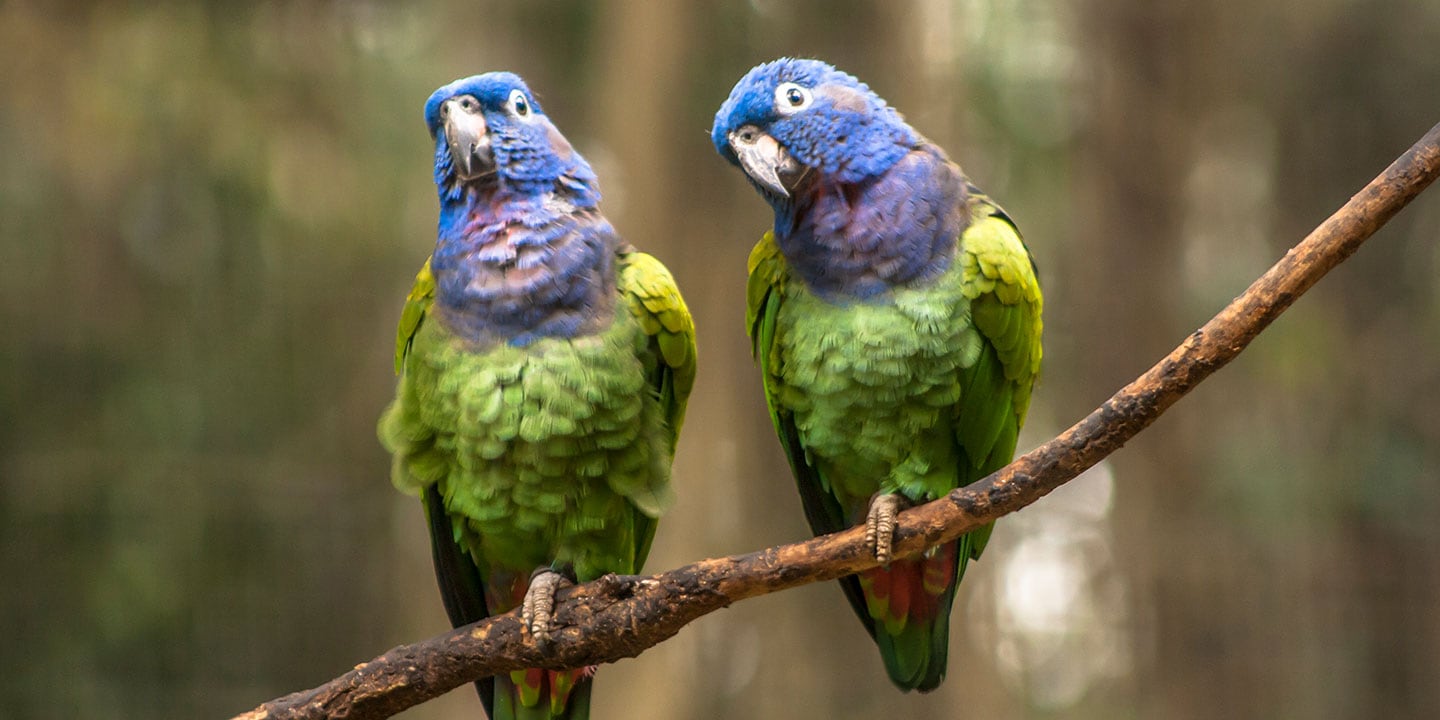
iStock.com/Alfribeiro
BEST FOR: First-time pet bird parents looking for a gentle, less-noisy parrot—but who have at least a couple of hours to play daily. They can be chatty, so they’re not ideal to own if you live in an apartment or townhouse.
Pionus parrots are medium-sized; they’re smaller than Amazons and African greys. They are such fun to live with! They love swinging, flying, hanging out, and watching whatever you are doing. They’re not as noisy and are more easygoing with a sweet disposition, making them excellent parrots for first-time bird parents who have the time to interact daily. They are easy to care for, very loving and playful, and have a mellow temper.
All About Pionus Parrots
- Average size and weight: 10 to 12 inches, 8 to 11 ounces
- Average lifespan: 20 to 40 years
- Sociability: They thrive on their own if they have plenty to do and at least two to four hours of time with you a day.
- Talking ability: They can learn to speak, but are not overly vocal.
- Medical concerns: Fungal infections; try to keep all pet birds in a well-ventilated room.
How To Keep Them Happy
Housing: Little acrobats, they enjoy roomy playtop bird cages which allow for plenty of exercise both inside and outside your pet’s home. Check out MidWest Avian Adventures Playtop Bird Cage.
Toys: Polly’s Pet Products Fun Roll Bird Toy gives birds an outlet for chewing and shredding instincts with a replaceable calculator paper roll.
Food: Formulated diets containing mostly pellets and more vegetables—like leafy greens, which have a high nutrient count—than fruits.
9. Finches
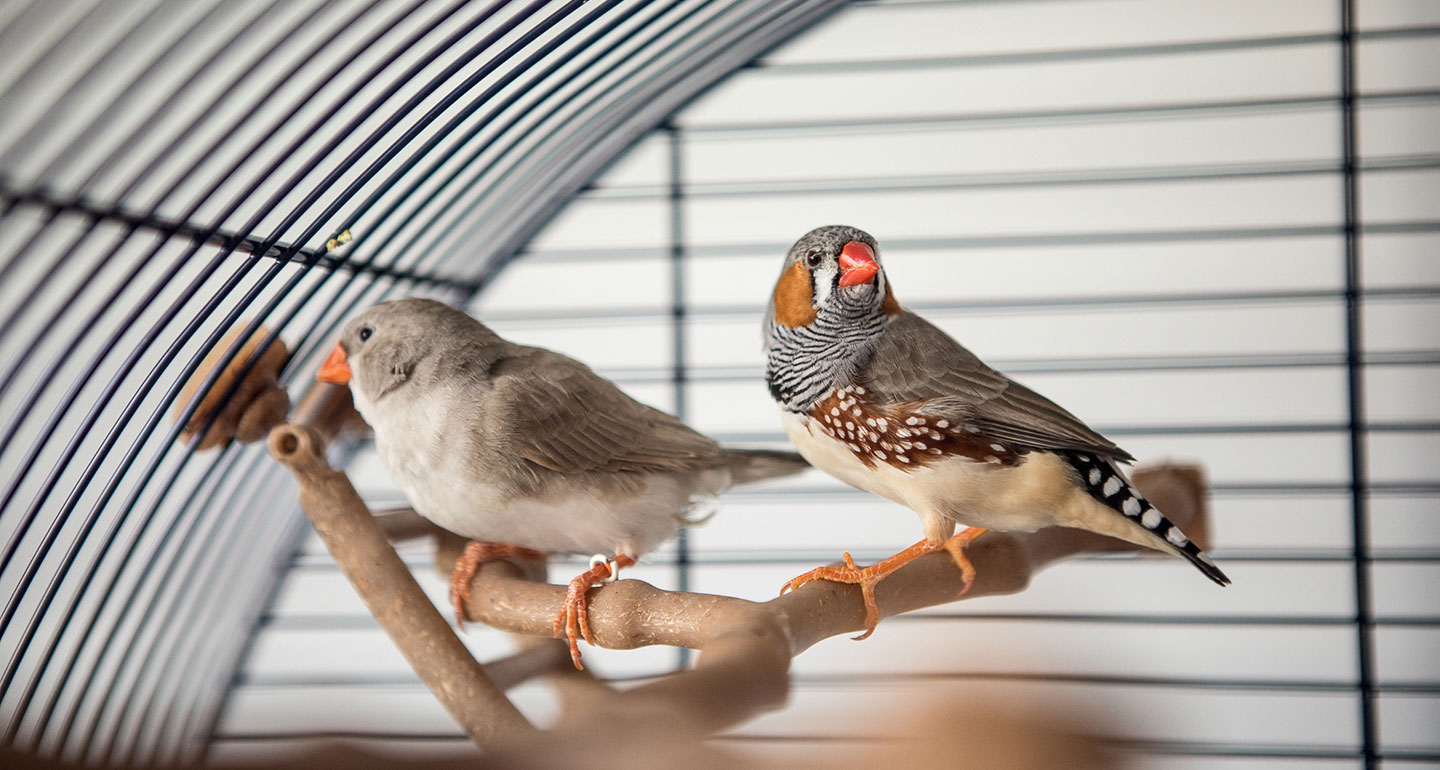
iStock.com/tucko019
BEST FOR: First-time pet bird parents who don’t have time to devote to training but love the chatter and energy pet birds bring to life. Their size is perfect for smaller spaces such as apartments or townhouses.
Super social finches should always live in groups of two or more. Finches are fun to listen to and watch. They come in various stunning colors and make quiet “beep, beep, beep” noises that many find pleasant. The three most common types of finches are society, Gouldian, and zebra. You can’t hold them; they’re meant for looking at.
All About Finches
- Average size and weight: 4-10 inches, 0.3 to 1.3 ounces
- Average lifespan: 4-10 years
- Sociability: They don’t need human interaction, but you can train some to perch on your finger; generally, they’re not into human contact.
- Talking ability: They don’t talk, but they’re very vocal!
- Medical concerns: Respiratory illness, mite infections (Learn more about pet bird mites.)
How To Keep Them Happy
Housing: Finches can entertain themselves if you give them a wide cage to fly around in, such as the Prevue Pet Products Small Bird Flight Cage, and put it in a room where you hang out, like the family or living room.
Toys: Foraging toys and materials for making nests (shredded paper works fine). The Super Bird Creations Paper Party Bird Toy has bright, rolled paper sticks for birds to shred.
Food: Pellet-based with some seeds mixed in, as well as greens like spinach, watercress and lettuce. And two bowls of water—one for bathing, one for drinking, both of which you should change daily.
10. Ring-Necked Doves

iStock.com/DOCUMENTARY-DIVER
BEST FOR: First-time pet bird parents who are looking for a quiet, devoted companion who can learn a trick or two, but who will mainly just hang out with them. Cooing is nice, with an almost ASMR effect.
Pretty, docile, and easygoing ring-necked and diamond doves are two of the most widely kept species of doves (some species aren’t well-suited as pets). They’re perfect for people who want to keep birds as pets but don’t want to (or can’t) invest the time necessary to care for a parrot. They’re not the most affectionate or intelligent (they’ll never learn to talk) birds of the bunch. But they might let you hold them, and they can learn to fly where you want them to with food incentives.
All About Ring-Necked Doves
- Average size and weight: 11 to 13 inches, 5 to 8 ounces
- Average lifespan: 10+ years
- Sociability: They’re fine on their own, but some love being petted and playing with their toys and you.
- Talking ability: They won’t speak human words but love cooing.
- Medical concerns: Calcium deficiency, parasites
How To Keep Them Happy
Housing: They need a wide cage with several perches, bells, and swings. JW Pet Swing N’ Perch provides birds like doves with a comfortable place to swing and perch.
Toys: Provide foraging toys and materials for making nests (shredded paper works fine). The Super Bird Creations Paper Party Bird Toy has bright, rolled paper sticks for birds to shred.
Food: Choose a commercial-prepared diet of pellets that is especially formulated for doves.
11. Lovebirds

iStock.com/yoh4nn
BEST FOR: Newbie bird owners, but it doesn’t hurt to have prior bird experience. These little buddies are noisy, so you must tolerate that. And if you want a fun-loving, playful little friend, you’ll need to spend time handling and talking to them.
Beautiful, colorful lovebirds are adorable little birds with cheerful personalities. Because they tend to mate for life, you might think you need two, but that’s untrue; two will bond with each other rather than with you. They love to nest. The male will strip newspaper into little strips that look like they came out of a shredder and stick them in his tail to bring to the nest area.
All About Lovebirds
- Average size and weight: 5 to 7 inches, 1-2 ounces
- Average lifespan: 10-15 years
- Sociability: They’re highly social birds, thriving on interaction with you or other lovebirds. They create strong bonds and can become aggressive if they feel threatened or neglected.
- Talking ability: They can mimic words and sounds, chirp and whistle, but are not known for their talking ability.
- Medical concerns: Respiratory infections, feather picking, vitamin A deficiency
How To Keep Them Happy
Housing: Lovebirds need a spacious cage—like the Yaheetech 54-in Rolling Metal cage—to move around freely and spread their wings. The cage should have perches and a nesting box.
Toys: They like small bird toys that are sparkly or a little jingly. Try Bonka Bird Toys’ Bellpull Bird Toy. (Opt for cowbell-style bells; lovebirds can get their toes caught in jingle bells.)
Food: Lovebirds require a varied diet. In addition to their pellet diet, provide lots of fresh produce for vitamin A: sweet potatoes, carrots, and dark green leafy vegetables. Clip the produce to the cage bars rather than chop it up and put it in a dish; they’re less likely to ignore it. Clean water should always be available.
12. Cockatoos
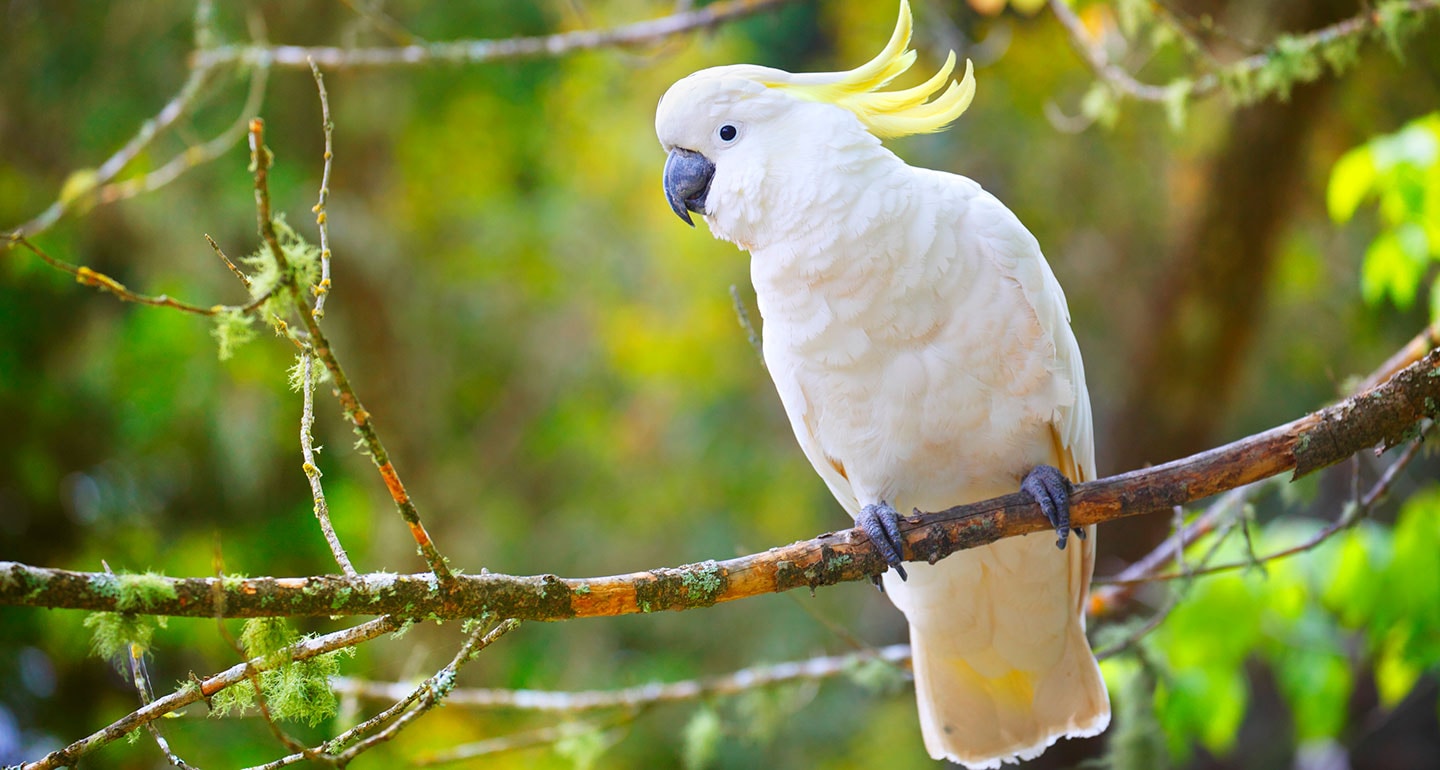
iStock.com/narvikk
BEST FOR: Experienced bird owners who are home all the time and have a lot of love to give. Cockatoos don’t like to be left alone and need a lot of attention or else they might scream and pick at themselves.
Cockatoos are the mushiest, sweetest birds in the whole world. They want their heads scratched 24 hours a day and love cuddling. Goffin’s cockatoos are particularly great pets; they’re quieter and smaller than Moluccan and umbrella cockatoos. But they’re needy—and they’re not for everyone. All varieties are prone to behavioral issues if they don’t get enough attention and socializing. The rule is to never let them think they can get more attention than they’re already getting.
All About Cockatoos
- Average size and weight: 12 to 27 inches, 10 to 30 ounces
- Average lifespan: 25 to 45 years
- Sociability: Cockatoos are super friendly birds. They can become quite attached to their humans and stressed or anxious when left alone.
- Talking ability: Cockatoos can mimic human speech but are less chatty than other parrot species.
- Medical concerns: Feather plucking, respiratory infections
How To Keep Them Happy
Housing: Cockatoos require a sturdy cage with space to move around and exercise. They also need plenty of movement and enrichment outside of the cage.
Toys: Cockatoos enjoy shredding toys, such as paper or cardboard, which can help satisfy their natural urge to chew. Regularly rotate safe, durable wood, rope, and leather toys to keep them interesting. See Chewy customer faves here.
Food: A pellet diet that’s formulated specifically for cockatoos is ideal. Fresh fruits and vegetables should make up a portion of their diet. Seeds can be an occasional treat.
13. Macaws

iStock.com/agustavop
BEST FOR: Executive-level bird owners willing to devote a lot of time, energy and space. Due to their noise levels and size, they’re not the best apartment pets.
These birds, which include scarlet, blue-and-yellow and hyacinth macaws, are not for everybody. They need a huge amount of space and attention, and they live 50 years, making them significant long-term commitments. (Consider setting up a pet trust because with a life span that long, they may outlive you.) Depending on how they were raised, they can be gentle giants, or they can be like temperamental 3-year-olds. They can be funny and puppyish, but they can also be destructive and loud.
All About Macaws
- Average size and weight: 30-42 inches, 2-4 pounds
- Average lifespan: 30-50 years, although some can live up to 80 years (yes, 80!)
- Sociability: Macaws can mimic and be chatty, but they’re not on the same level as African greys.
- Talking ability: They don’t talk, but they’re very vocal!
- Medical concerns: Parrot fever, feather picking, respiratory infections
How To Keep Them Happy
Housing: Macaws need A LOT of space. The larger the cage, the better. Supplement their environment with play stands and perches outside of the cage.
Toys: Large blocks, swings, ladders, and puzzles that require the bird to work for a reward are all good toy options.
Food: High-quality pellet, such as Zupreme Smart Selects (which is a brand our experts recommend for all birds) or seed mix supplemented with fresh fruits and vegetables. Their powerful beaks can easily crack nuts and seeds.
Getting a pet bird is a big decision, and as you can tell based on their lifespans, a life-long commitment. But the rewards are totally worth it—as long as you do your research ahead of time. Talk to an avian veterinarian, a breeder, or someone educated in a particular bird species before choosing the right bird for you. And don’t forget to take your new feathered friend to the vet as soon as possible for a health check.
